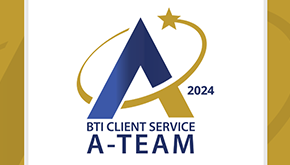Five Key Takeaways from INTA’s The Business of AI Conference
The International Trademark Association (INTA) held their “The Business of Artificial Intelligence” Conference on March 20-21 in New York City. The program included a diverse group of speakers who covered all manner of topics concerning AI and its impact on business, the law and our everyday lives. The presentations and panels were thought provoking and designed to bring the participants up to speed on the current state of AI and to open our minds to questions about how we will proceed with using AI in the future.
During the conference, INTA defined AI as computers performing tasks requiring human-like intelligence, such as learning, reasoning, problem-solving, understanding language and creativity. The AI creates algorithms to analyze data, make decisions, recognize patterns and automate tasks. The aim is to enhance and expand abilities of machines and humans in various tasks, from simple automation to complex decision making.
1. AI is already everywhere, but is not everything
AI is a hot topic in the news and has been for the past year or so. The current news about AI is focused on generative AI (GenAI), which is AI that creates new content like text, images, music or speech. However, AI has been used for many years for data analysis and responding to prompts. In 1997, Deep Blue, an IBM chess supercomputer, beat chess world champion Garry Kasparov in a six-game match. Since then, AI has been used to improve the thinking and analyzing capabilities of computers and machines throughout technology fields. These days AI can be found in computers providing a wide variety of services, such as search engines, self-driving vehicles, traffic flow analysis, online chatbots, weather forecasting equipment, image analysis, video games, real-time fraud processing, customer trend analysis, customer recommendation generation, drug and treatment development, disease diagnosis, automated manufacturing, movie special effects, and image, sound, text and video generation, to name a few.
However, while AI is everywhere, it is not able to do everything. Almost all AI currently in use is considered “narrow AI,” meaning that it is programmed to perform specific tasks. Currently, AI works under limited intelligence and lacks broad intelligence. An AI programmed and trained for a self-driving car would not be able to provide weather forecasts. It appears that General AI, aka human-like intelligence and/or broad problem solving, is beyond current AI technology.
2. AI makes mistakes
AI is not perfect. It still makes mistakes and sometimes provides nonsensical, illogical or wrong results. These are called “AI hallucinations” and may be based upon misinterpretations or incorrect processing of data, insufficiently diverse or biased training data, opaque decision-making processes, and/or misidentifying objects or seeing nonexistent patterns.
Many of these hallucinations in GenAI have provided amusing results. For example, image generation AIs have created images with floating objects, images of real-world locations with extra landmarks, text documents with incorrect data, and other oddities. Furthermore, created videos may have an unreal quality to them, for example, creating impossible physics, such as people walking without moving their legs or having objects float in mid-air. Some have provided fictional information as fact.
At this point, AI still requires a human in the loop to analyze the results and confirm that the output is correct.
3. AI is not secure
Many AI programs are constantly being updated by user inputs and user response to their outputs. This means that the AI program may use information provided by users for training and then potentially output some or all of that information in future outputs, even to other users. Different AI programs leverage user input in different ways. It is always important to review the terms and conditions of any AI-based program or service. It is also very important to be careful about what information you share with AI programs and services, especially private or personal information. Closed, fenced-in, or no retention AI programs and services do exist, which do not save or reuse user-provided information.
4. The regulation of AI has already started
Recently, the EU passed the AI Act, a comprehensive set of regulations aimed at governing AI and its use. However, many other countries have also regulated different aspects of AI. China passed a series of AI laws that include regulations for recommendation engines and deepfakes. The Biden administration issued an Executive Order in October 2023 that provided guiding principles and new Standards for AI Safety and Security. Both the U.S. Patent and Trademark Office and the U.S. Copyright Office have issued guidelines on whether AI output is patentable or copyrightable. And the state of Utah has determined that AI may not be blamed as a defense for deceptive acts that harm consumers. Tennessee recently passed the ELVIS Act to protect musicians from unauthorized usage by AI. There are also multiple potential laws and regulations that are working their way through law-making bodies around the world.
5. AI should be used with caution
AI-based tools may help many different industries, but users should still take caution. Using AI tools may save many hours of work, especially for repetitive and/or tedious tasks. However, the outputs should always be reviewed before using. While current AI tools may be useful for searching and analyzing large amounts of data, the output of GenAI should be scrutinized closely. While GenAI may be good for generating a template for a person to fill in, such as for a specific type of email or other document, GenAI should not be used for creating a filled out or completed document. Paraphrasing one speaker, the GenAI output is comparable to work product you might expect from a first-year employee right out of school. It should be reviewed carefully as it doesn’t have the learned experience of a more seasoned professional. In the future, AI’s output will improve, but users should always be careful about anything that is submitted to a client, regulatory authority or others.
Conclusion
I am looking forward to watching the AI industry develop over the next year. It is an exciting field that is growing rapidly, but one that requires careful review of its outputs. It is good to remember that while some of the results of AI look amazing, the systems behind AI are still very much in development.









































